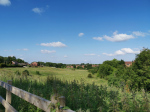You can’t rob a place of everything it’s seen
Bridleway (noun): A route which may be travelled by foot, on horseback or on a bicycle
A sense of expectancy is rife on the bridleway. Arching trees curl over my head and neighbouring roads and fields are hidden. As I walk the unique, uncanny flatness, I can’t help but feel that there’s something waiting to happen – something not even here in this present day.
Compare being on this former railway to preparing to cross a modern-day one: that pressured silence as you listen out for trains, that thrum of fear that one could sound its horn at any second, that mad dash you’re about to make, away from any possible danger. It seems that as old railways transitioned into bridleways, the dangerous feeling they carry has not been expelled.

For a place so hilly as Saddleworth, the linearity of this place (sometimes even referred to as the ‘linear path’) puts it at odds with anything beyond its own borders. My feeling of separation from the rest of the world is so poignant that the laws of nature could have been suspended for all I know.
All there is on the bridleway is a stillness and a stuck-ness.
It’s not an unpleasant sensation, rather it’s quiet and mindful. Surely, the year doesn’t matter to the air, trees, or leaves? Any presupposing rustle could indicate the arrival of a train behind me, and the natural world wouldn’t be surprised. It feels like this transformed place could be transformational still.

I recently wrote about how time over lockdown didn’t feel linear to me, how the feelings associated with it circled back around constantly, like we were in a ‘loop’. Bridleways, despite their physical appearance, can give much the same effect. The agency and power of trains in their heyday has left the paths now quiet and expectant. They’re stuck in their own pocket of time wherein an engine could rattle past, steam billowing, or a contented walker could bounce along, and either would be equally valid. The lasting eyes of nature have seen it all, been there across all-time, watching conversion after conversion. What’s a small century to them? Horse, train, human, repeat.
Saddleworth’s bridleways were, as referenced, railways, in centuries gone by, and we could say that what most survives of that time is the word ‘way’. Outliving ‘railway’ into ‘bridleway’, the word suggests movement, progression and activity. These routes have always been active places; steam engines have rocketed through, horse riders have clopped along, walkers have ploughed to their next destination, coal has been shovelled, tracks have been laid, trees have been planted, viaducts have been demolished, stations have been rowdily crowded before being converted into quiet homes. No wonder time seems to exist differently here – countless journeys are always in motion.

Walking on, I take quick glances behind me. They reveal there’s nothing there but kind trees and swaying bushes. I know it’s impossible, but it feels like the history of this place isn’t far away from my own steps, my own breaths. Some radical philosophies claim that everything that has ever happened (and will happen) has its own specific ‘co-ordinate’ in space and time. A train chugging along the Delph Donkey line one particular Tuesday morning in 1860 is just as valid a co-ordinate as me traversing the very same space on a particular Saturday afternoon in 2020. This ‘Box Universe’ theory suggests that our universe exists inside a block of ‘space-time’, and someone looking into the block from outside would be able to see all the co-ordinates laid out in their rows. Some philosophers go so far as to suggest that because the co-ordinates co-exist inside the block, they are all happening at the same moment, and our perception of the past and future is only so linear because we are inside the block, looking subjectively back at what has already happened and wondering what might happen next. Unlike the onlooker, we can’t see everything together. Although we cannot prove this mind-bending idea, as I stop and stand still on the path, it is fascinating to picture that our so-called ‘past’ may not be as distant as we perceive it. The strange, pregnant air on the bridleway may almost signal that we are not so far away from the co-ordinate where trains suddenly rattled round corners, here.

On my left, the station-house waits for something that won’t come, has the urgent tick of a ‘used-building’, purpose-built – a ghoul aching to see a glimpse of its old life. It is beautiful too; stately and spacious, crowned with wilderness. Ahead, the end of the path is in sight. I leave, entering back into what is unmistakeably 2020, and the bridleway sits behind me, unfazed. It’s always there to return to, in its own little slice of space and time. You can’t rob a place of everything it’s seen.


